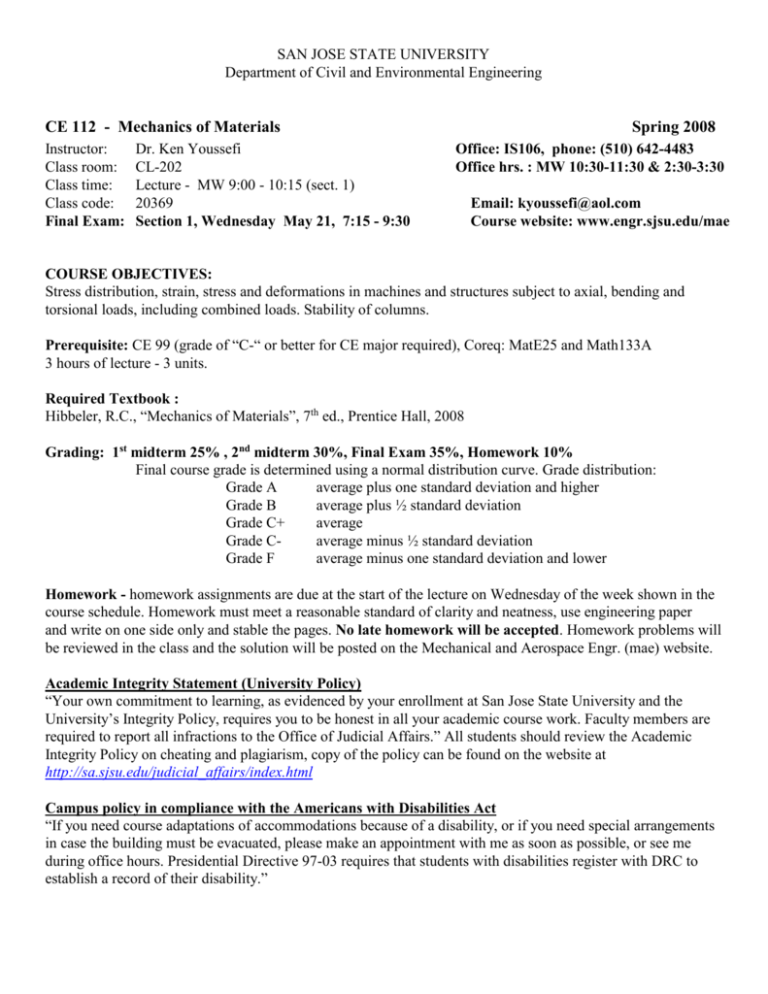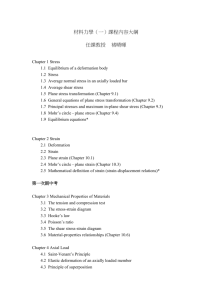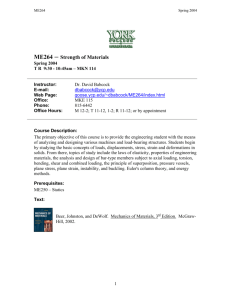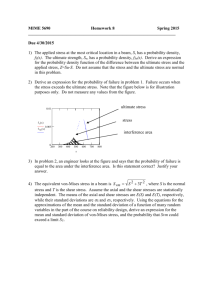CE112 course syllabu.. - San Jose State University
advertisement

SAN JOSE STATE UNIVERSITY Department of Civil and Environmental Engineering CE 112 - Mechanics of Materials Instructor: Class room: Class time: Class code: Final Exam: Dr. Ken Youssefi CL-202 Lecture - MW 9:00 - 10:15 (sect. 1) 20369 Section 1, Wednesday May 21, 7:15 - 9:30 Spring 2008 Office: IS106, phone: (510) 642-4483 Office hrs. : MW 10:30-11:30 & 2:30-3:30 Email: kyoussefi@aol.com Course website: www.engr.sjsu.edu/mae COURSE OBJECTIVES: Stress distribution, strain, stress and deformations in machines and structures subject to axial, bending and torsional loads, including combined loads. Stability of columns. Prerequisite: CE 99 (grade of “C-“ or better for CE major required), Coreq: MatE25 and Math133A 3 hours of lecture - 3 units. Required Textbook : Hibbeler, R.C., “Mechanics of Materials”, 7th ed., Prentice Hall, 2008 Grading: 1st midterm 25% , 2nd midterm 30%, Final Exam 35%, Homework 10% Final course grade is determined using a normal distribution curve. Grade distribution: Grade A average plus one standard deviation and higher Grade B average plus ½ standard deviation Grade C+ average Grade Caverage minus ½ standard deviation Grade F average minus one standard deviation and lower Homework - homework assignments are due at the start of the lecture on Wednesday of the week shown in the course schedule. Homework must meet a reasonable standard of clarity and neatness, use engineering paper and write on one side only and stable the pages. No late homework will be accepted. Homework problems will be reviewed in the class and the solution will be posted on the Mechanical and Aerospace Engr. (mae) website. Academic Integrity Statement (University Policy) “Your own commitment to learning, as evidenced by your enrollment at San Jose State University and the University’s Integrity Policy, requires you to be honest in all your academic course work. Faculty members are required to report all infractions to the Office of Judicial Affairs.” All students should review the Academic Integrity Policy on cheating and plagiarism, copy of the policy can be found on the website at http://sa.sjsu.edu/judicial_affairs/index.html Campus policy in compliance with the Americans with Disabilities Act “If you need course adaptations of accommodations because of a disability, or if you need special arrangements in case the building must be evacuated, please make an appointment with me as soon as possible, or see me during office hours. Presidential Directive 97-03 requires that students with disabilities register with DRC to establish a record of their disability.” College and Department Policy You are responsible for understanding the policies and procedures for add/drop, academic renewal, withdrawals, incomplete grade, classroom behavior, and other policies described in the catalog. Please read your catalog thoroughly. We will review the evacuation plan for this classroom during the first day meeting, please see me about the evacuation plan. Course Objectives: To derive and apply the basic analysis techniques for determining stresses, strains, and deflections in structural and machine members under axial, torsional, and bending loads, and combinations thereof. To design components by selecting material and calculating the maximum stresses caused by applied loads. Student Learning Objectives Students should demonstrate the ability to: 1. Calculate internal forces and moments in elements of simple structures and plot their distribution. 2. Explain the concept of average normal and shear stress. 3. Explain the concept of normal and shear strain. 4. Calculate normal and shear stress, normal strain, and length change in axially loaded members under mechanical and thermal loads, including statically indeterminate assemblies. 5. Calculate shear stress in rotating circular shafts, including statically indeterminate assemblies. 6. Calculating normal and shear stresses in straight beams under concentrated and distributed loads. 7. Compute membrane stresses in thin-walled pressure vessels. 8. Determine the state of stress caused by combined loading; axial, bending and torsion 9. Transform stress to arbitrary reference axes in two dimensions, and calculate principal stresses and maximum shear stresses and show their orientations (Mohr’s Circle). 10. Design columns; calculate the critical load to avoid buckling (Euler). 11. Design beams, shafts, and other structural components. COURSE SCHEDULE Week/Date 1 1/23 2 1/28 1/30 3 2/4 4 2/6 2/11 2/13 5 8 2/18 2/20 2/25 2/27 3/3 3/5 3/10 9 3/12 3/17 6 7 3/19 Subject Reading Assign.(article) Homework problems Introduction, course organization Homework is due on the Equilibrium equations, normal and shear stress. 1.1-1.3 Wed. of the week indicated Axially loaded bar, design using allowable stress. 1.4 - 1.6 Strain: normal and shear strain, examples 2.1, 2.2 Mechanical properties of material: 3.1 - 3.3 tension-compression tests, stress-strain diagram Hooke’s Law, strain energy, examples, 3.4 - 3.7 1.6, 1.16, 1.25, Poisson’s ratio, shear stress-strain diagram, 1.35, 1.59, 1.89 Axial load: elastic deformation and superposition 4.1 - 4.3 Statically indet., force method, thermal stresses 4.4 - 4.6 2.8, 3.4 (Excel), 3.17, Torsion: deformation of a circular shaft, shear 5.1 - 5.3 3.22, 3.23, 3.31 stress equation, power transmission Torsion: angle of twist, examples 5.4 4.4, 4.17, 4.19, Statically indeterminate and non-circular members. 5.5, 5.6 4.32, 4.57, 4.78 Bending: shear and moment diagram, deformation 6.1, 6.3 5.9, 5.25, 5.35, of a straight member, the flexure formula 6.4 5.50, 5.54, 5.140 Exam review Midterm Exam 1 Transverse shear: shear in straight members, 7.1-7.5 6.3, 6.7, 6.33 shear stresses in beams, shear flow, build-up and 6.73, 6.89, 6.99 thin-walled members. Combined loading: thin-walled pressure vessels 8.1, 8.2 Stress transformation, principal stresses, 9.1-9.3 7.4, 7.18, 7.28 maximum in-plane shear stress. 7.37, 7.40 Mohr’s circle, absolute max. shear stress 9.4, 9.7 10 3/24 – 3/28 11 3/31 4/2 12 13 14 15 4/7 4/9 4/14 4/16 4/21 4/23 4/28 4/30 two prob.) 16 5/5 5/7 17 5/12 Spring Recess Holiday – Cesar Chavez Day Stress in shafts due to axial and torsional loads Stress variation throughout a cross section Plane strain transformations, strain rosettes Stress-strain and material properties relationships Design of beams and shafts Deflection of beams and shafts Method of superposition Statically indeterminate beams and shafts Exam review Midterm Exam 2 Buckling of columns: critical load Buckling of columns: various end conditions. Column design The secant formula Example problems Last day – final exam review 9.5 10.1-10.5 10.6 11.1, 11.2, 11.4 12.1, 12.2 12.5-12.7 12.9 8.4, 8.5, 8.19 8.27, 8.42 9.9, 9.25, 9.30, 9.46, 9.47, 9.53 10.39, 11.3, 11.12, 11.13, 11.22, 11.23, 13.1-13.2 13.3 12.5, 12.26, 12.95 12.121 (use superpos. for the last 13.4 13.11, 13.23, 13.33, 13.35 ky
![Applied Strength of Materials [Opens in New Window]](http://s3.studylib.net/store/data/009007576_1-1087675879e3bc9d4b7f82c1627d321d-300x300.png)






